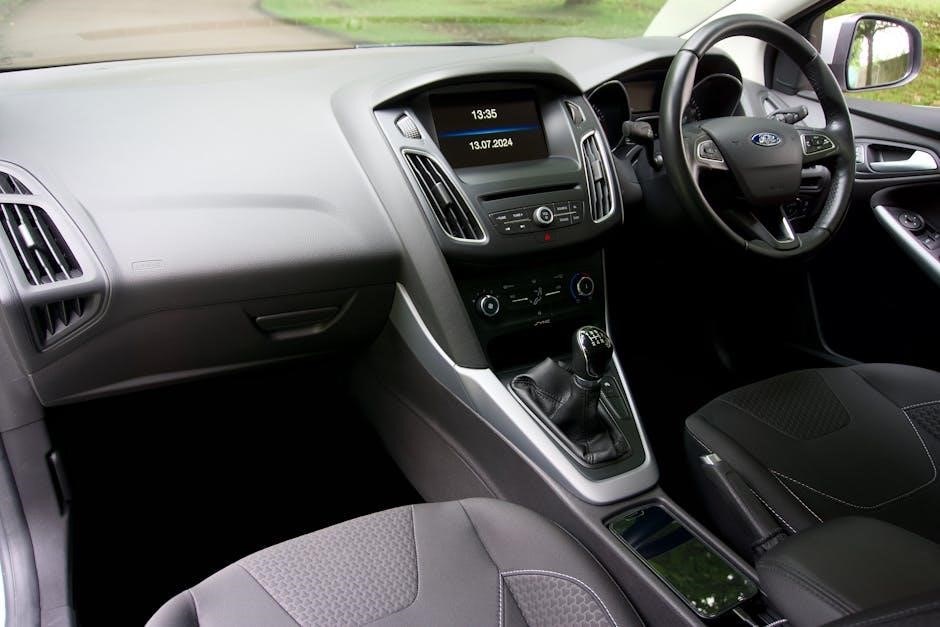PDFs are widely used for their versatility and security, making them essential for personal and professional tasks. iPhones offer built-in tools and apps like PDFelement for seamless PDF management, enabling users to view, edit, and share files efficiently on the go.
1.1 Importance of PDFs in Daily Use
PDFs (Portable Document Formats) are essential for daily tasks due to their versatility and security. They maintain document integrity across devices, ensuring consistent formatting. PDFs are widely used for professional documents, legal contracts, and educational materials. Their ability to be password-protected enhances security, making them ideal for sensitive information. Additionally, PDFs are easily shareable and accessible on all platforms, including iPhones. They serve as a universal format for user manuals, receipts, and eBooks, simplifying communication and organization. The convenience of PDFs in preserving layouts and enabling annotations makes them indispensable for both personal and professional workflows, fostering efficiency and reliability in everyday digital interactions.
1.2 Brief Overview of iPhone PDF Capabilities
iPhones offer robust PDF handling capabilities, enabling users to view, edit, and manage PDFs seamlessly. Built-in apps like Books and Files provide native support for opening and organizing PDFs. iOS integrates intuitive markup tools, allowing annotations and comments directly on PDFs. Third-party apps like PDFelement expand functionality, offering advanced editing features. iCloud and cloud storage services ensure easy access and sharing of PDFs across devices. Additionally, the ability to convert various file types to PDF and vice versa enhances productivity. These features make iPhones a versatile tool for managing PDFs, catering to both casual users and professionals who require advanced document handling on the go.

Opening PDF Files on iPhone
PDFs can be easily opened on iPhone using built-in apps like Books or Files, or third-party apps like Acrobat Reader, ensuring quick and seamless access to documents.
2.1 Default PDF Viewers on iPhone
The iPhone comes with default apps like Books and Files that can open PDFs without additional downloads. These apps provide basic viewing features, such as zooming and scrolling through documents. They also allow users to organize and store PDFs locally. For a more enhanced experience, users can opt for third-party apps like Acrobat Reader, which offers advanced features like annotations and form filling. These default viewers are sufficient for casual use, while power users may prefer specialized PDF readers for additional functionality. The integration of these apps ensures a seamless experience for managing PDFs on iOS devices.
2.2 Opening PDFs from Email Attachments
To open PDFs from email attachments on your iPhone, locate the email with the PDF in the Mail app. Tap the PDF attachment to preview it. You can then choose to save it to the Files app or Books app by tapping the share button. Additionally, you can directly open the PDF in other installed PDF readers like Acrobat Reader or PDFelement. If you need to save the PDF for later, tap the Save to Files option, which allows you to store it in a specific folder. This seamless integration makes managing PDFs from emails straightforward and efficient on iOS devices.
2.3 Accessing PDFs from Safari
To access PDFs from Safari on your iPhone, locate the PDF link on a webpage and tap it to open. Safari will display the PDF in its built-in viewer. You can zoom in or out using pinch gestures and scroll through pages by swiping. To save the PDF, tap the Share icon (a square with an arrow) and select Save to Files or Save to Books. You can also open the PDF in other apps like Books or Acrobat Reader by choosing the appropriate option from the share menu. This feature makes reading and managing PDFs directly from the web convenient and efficient on iOS devices.
2.4 Opening PDFs from Cloud Storage
To access PDFs stored in cloud services like iCloud, Google Drive, or Dropbox on your iPhone, open the respective app and navigate to the folder containing your PDF. Tap the PDF file to open it in the app’s built-in viewer. Depending on the app, you may need to download the file first. Once opened, you can use pinch-to-zoom gestures to adjust the view or scroll through pages. To save the PDF to your device, tap the Share icon (a square with an arrow) and select Save to Files or another storage location. This method ensures easy access to your PDFs from any cloud storage service directly on your iPhone.

Editing PDFs on iPhone
iPhones offer robust tools for editing PDFs. Use Markup for annotations or third-party apps like PDFelement for advanced editing. Convert, annotate, and manage PDFs efficiently on the go.
3.1 Built-in Markup Tools in iOS

iOS provides powerful built-in Markup tools for editing PDFs. Open a PDF in the Files app, tap the Markup icon to access annotation tools, and easily add text, highlight, or draw. Markup allows users to insert signatures, add comments, and customize annotations with different colors and sizes. These tools are user-friendly and integrated seamlessly into the iPhone’s operating system, making it simple to edit and annotate PDFs without third-party apps. Markup is also available in other apps like Mail and Safari, enhancing your productivity on the go.
3.2 Using Third-Party PDF Editors
Third-party apps like PDFelement, Adobe Acrobat Reader, and others offer advanced PDF editing features on iPhone. These apps allow users to edit text, add annotations, fill forms, and merge PDFs. To use them, download the app from the App Store, open your PDF, and access tools like text editing, annotations, and form filling. Many apps also support converting PDFs to editable formats like Word. While iOS has built-in tools, third-party editors provide more robust features for complex tasks. They are ideal for users needing detailed editing capabilities, enhancing productivity for both personal and professional use on iPhone and iPad.
3.3 Adding Annotations and Comments
Adding annotations and comments to PDFs on iPhone is straightforward using Markup tools. Open the PDF in the Files app, tap the Markup icon, and select tools like highlight, underline, or pen. Users can also add text boxes for comments. Third-party apps like PDFelement offer additional annotation features, such as stickers and custom stamps. To share annotated PDFs, tap the Share button and choose options like email or cloud storage. These features are essential for collaboration and note-taking, making PDFs interactive and functional for both personal and professional use on iOS devices.
3.4 Filling Out PDF Forms
Filling out PDF forms on iPhone is efficient with apps like PDFelement or Adobe Acrobat. Open the PDF via the Files app or email, then tap form fields to input text. Use the keyboard for typing and utilize features like checkboxes and dropdown menus. After completing the form, save or share it using the app’s options. Adding a signature is also possible, enhancing the document’s authenticity. These apps streamline form filling, making it easy to handle professional and personal tasks on the go. Ensure to explore app tutorials for optimal use of features and tools.
3.5 Converting PDFs to Editable Formats
Converting PDFs to editable formats like Word or Excel on iPhone is essential for editing content. Use apps like PDFelement or Adobe Acrobat, which offer export options. Open the PDF, tap the export feature, and choose the desired format. Ensure the converted file retains its layout and clarity. For Word documents, saving as PDF is straightforward via the “Save As” option; Built-in iOS features and third-party apps simplify this process, enabling seamless editing on the go. Always preview the converted file to ensure accuracy and make necessary adjustments before sharing or further editing.

Managing PDF Files on iPhone
Managing PDFs on iPhone is effortless with the Files app, allowing organization into folders, tagging, and access via iCloud or other cloud services seamlessly.
4.1 Organizing PDFs in the Files App
Organizing PDFs in the Files app on iPhone is straightforward. Users can create folders, name them, and move PDFs into them for easy access. Additionally, tagging PDFs with colors or keywords enhances visibility and quick retrieval. iCloud synchronization ensures that all organized PDFs are available across devices. The app also allows bulk selection, making it simple to manage multiple files at once. This system helps users maintain a clutter-free and efficient storage solution for their PDF documents, ensuring they can locate specific files quickly when needed. Proper organization is key to productivity, especially for those handling numerous PDFs regularly.
4.2 Creating Folders and Tagging PDFs
Creating folders and tagging PDFs in the Files app on iPhone helps streamline organization. Users can tap “New Folder” in the sidebar to create one, then drag and drop PDFs into it. Tags, available in various colors, can be applied to PDFs for quick identification. To tag, select the PDF, tap the “Tags” option, and choose or create a tag. This system allows users to categorize files by project, type, or priority, making them easier to locate. Folders and tags sync across iCloud, ensuring consistency on all devices. This feature is particularly useful for managing large collections of PDFs efficiently and maintaining a tidy digital workspace.
4.3 Merging Multiple PDFs into One
Merging multiple PDFs into a single file on an iPhone can be accomplished using the Files app or third-party tools; Open the Files app, select the PDFs you wish to combine, and use the “Merge” option if available. For more advanced merging, apps like PDFelement allow you to import multiple PDFs, arrange them, and export as one file. This feature is ideal for compiling reports, documents, or presentations. Ensure your device is updated for compatibility, and explore app settings for customization options like rearranging pages or adding covers. This streamlined process enhances productivity and keeps your PDF library organized and easily accessible.
4.4 Deleting and Recovering PDFs
Managing PDFs on your iPhone involves both deletion and recovery. To delete a PDF, locate it in the Files app, tap and hold, then select “Delete.” For recovery, check the “Recently Deleted” folder within the Files app, where items are stored for up to 30 days. If the PDF was stored in iCloud, you can recover it from iCloud Drive’s “Recently Deleted” section. Third-party apps like PDFelement also offer trash recovery options. Regular backups, such as using iCloud or other cloud services, ensure that your important PDFs are safe and can be restored if accidentally deleted, providing peace of mind and data security.

Converting Files to PDF on iPhone
Converting files to PDF on iPhone is straightforward. Use the share button, select “Print,” and adjust settings to save as PDF. Third-party apps also offer advanced conversion tools for various file types.
5.1 Converting Photos to PDF
To convert photos to PDF on iPhone, open the Photos app, select the desired image, and tap the Share icon. Choose the Print option, then adjust the settings if needed, and save as PDF. This method allows quick conversion of individual photos into PDF format. Alternatively, you can use third-party apps like PDFelement for batch conversions and advanced editing features. The converted PDF can be saved to the Files app or cloud storage for easy access. This feature is particularly useful for sharing or organizing photos in a professional format.
5.2 Converting Word Documents to PDF
To convert Word documents to PDF on iPhone, open the Word app, select the document, and tap the Share icon. Choose Export and then PDF to save the file. Alternatively, use third-party apps like PDFelement for advanced conversion options. These apps often support batch processing and password protection for secure PDFs. Once converted, the PDF can be stored in the Files app or uploaded to cloud storage. This method ensures your Word files are easily shareable and maintain their formatting when converted to PDF. It’s a convenient solution for professional and personal use.
5.3 Converting Web Pages to PDF
To convert web pages to PDF on your iPhone, open the page in Safari and tap the Share icon. Select Convert to PDF from the options, then choose Save to Files to store it. For more customization, use third-party apps like PDFelement, which offers advanced formatting and password protection. These tools allow you to adjust layout, add watermarks, and secure your PDFs. Converted web pages are saved in the Files app or cloud storage, ensuring easy access and sharing. This feature is ideal for saving articles, receipts, or important information offline, maintaining their original formatting and images for future reference.
5.4 Using Shortcuts to Convert Files
To streamline file conversion on your iPhone, use the Shortcuts app. Open the app, tap the “+” icon to create a new shortcut, and add the Convert to PDF action. Select the file type you want to convert, such as photos or web pages, and specify the output format. Save the shortcut and name it for easy access. You can also customize it by adding additional actions, like saving the PDF to a specific folder or sharing it via email. This automation saves time and simplifies repetitive tasks, making it easier to manage documents on the go. Experiment with different actions to create tailored workflows for your needs.

Sharing and Printing PDFs
Sharing and printing PDFs on iPhone is straightforward, allowing users to efficiently manage documents. Share via email, messaging, or cloud storage, and print using AirPrint for convenience. Access these options through the share button for quick actions.
6.1 Sharing PDFs via Email and Messaging
To share PDFs via email or messaging on your iPhone, locate the PDF in the Files app or a storage service like iCloud. Tap the share icon, then choose a sharing method such as Mail or Messages. Enter the recipient’s details and send. For quick sharing, AirDrop allows transferring PDFs directly to nearby devices without opening another app. This feature is particularly useful for seamless collaboration and ensures your documents reach their destination efficiently.
6.2 Sharing PDFs to Cloud Storage
Sharing PDFs to cloud storage on your iPhone is a convenient way to access files across devices. Open the Files app and select the PDF you wish to share. Tap the share icon, then choose a cloud service like iCloud, Google Drive, or Dropbox. Follow the prompts to upload or save the PDF directly to your chosen storage. This method ensures your documents are securely stored and easily accessible from any device with internet access, making collaboration and file management straightforward and efficient.
6.3 Printing PDFs from iPhone
Printing PDFs from your iPhone is a straightforward process. Open the PDF file using the Books app or any PDF viewer. Tap the share icon, then select the print option. Choose an AirPrint-enabled printer connected to your Wi-Fi network. Adjust settings like page range or orientation if needed, then confirm to print. This feature is convenient for hard-copy needs and works seamlessly with compatible printers, ensuring high-quality output directly from your device.
6.4 AirDrop for PDF Sharing
AirDrop is a seamless way to share PDFs between Apple devices. Ensure AirDrop is enabled in Settings under General, set to “Everyone” for visibility. Open the PDF in your app, tap the share icon, and select AirDrop. Choose the recipient’s device from the nearby list. The recipient receives a notification to accept the file. AirDrop uses Bluetooth and Wi-Fi, so ensure both devices have these enabled. For privacy, set AirDrop to “Contacts Only” in public spaces. If issues arise, check settings, network connections, and restart devices. AirDrop is a convenient, wireless method for quick file transfers between Apple devices.

Advanced PDF Features on iPhone
Advanced features include Night Mode for better readability, bookmarks for navigation, and Continuity to start tasks on one Apple device and resume on another seamlessly.
7.1 Using Continuity for PDFs
Continuity allows seamless integration across Apple devices, enabling users to start editing a PDF on their iPhone and resume on a Mac or iPad effortlessly. This feature enhances productivity by eliminating the need to transfer files manually, ensuring a smooth workflow. With macOS Catalina or later and iOS 13 or later, users can access the same PDF document on multiple devices, maintaining their work progress and ensuring consistency. This functionality is particularly useful for tasks that require collaboration or transitioning between devices, making it a powerful tool for both personal and professional use.
7.2 Enabling Night Mode for PDFs
Night Mode enhances readability in low-light environments by inverting colors, reducing eye strain. To enable it, go to Settings > Display & Brightness, then toggle on Night Shift. For PDFs, open the file, tap the screen to reveal controls, and adjust brightness or enable Night Mode manually. This feature is especially useful for reading PDFs at night, ensuring comfort and clarity. iPhones also support automatic scheduling for Night Mode, adapting to your environment seamlessly. Additionally, users can customize color temperatures to optimize their reading experience further, making PDF viewing more accessible and visually appealing in any setting.
7.3 Bookmarking Pages in PDFs
Bookmarking pages in PDFs on your iPhone allows for quick access to important sections. To add a bookmark, open the PDF using the Books app or a PDF viewer. Navigate to the desired page, then tap the center of the screen to reveal the controls. Select the bookmark option, often represented by a ribbon icon or a “Bookmark” button. Some apps also let you add notes or labels to bookmarks for better organization. To manage bookmarks, tap the table of contents icon or the bookmarks tab, where you can edit or delete them. This feature is ideal for referencing specific sections frequently, enhancing productivity and readability on the go.
7.4 Searching Within PDFs
Searching within PDFs on your iPhone is a convenient feature that saves time when looking for specific text. To search, open the PDF in an app like Books or Acrobat Reader. Tap the center of the screen to reveal the controls, then select the search icon (often a magnifying glass) or use the keyboard that appears. Type your query, and the app will highlight all matching text within the document. This feature is especially useful for long documents or when referencing specific information quickly. Many PDF viewers also support advanced search options, such as searching for multiple terms or navigating through results seamlessly.

Security and Privacy for PDFs
Protecting sensitive information in PDFs is crucial. iPhones support password protection, encryption, and secure sharing options to ensure your documents remain confidential and accessible only to intended recipients.
8.1 Password Protecting PDFs
Password protecting PDFs on iPhone ensures your sensitive documents remain secure. Using apps like PDFelement, you can easily set a password by opening the PDF, selecting the lock icon, and following the prompts to create a strong password. This feature prevents unauthorized access, making it ideal for confidential files. Additionally, built-in iOS features allow you to encrypt and protect PDFs with Face ID or Touch ID, adding an extra layer of security. Always use complex passwords and store them safely to maintain document integrity and privacy. This method is highly recommended for personal and professional use.
8.2 Encrypting PDF Files
Encrypting PDF files on iPhone adds an extra layer of security, ensuring only authorized users can access the content. Using apps like PDFelement, you can encrypt PDFs by opening the file, selecting the lock icon, and setting a strong password. Built-in iOS features also support encryption through Face ID or Touch ID. This method is ideal for sensitive documents, as it prevents unauthorized access. Always use complex passwords and store them securely. Encryption is a reliable way to protect your PDFs from breaches, especially when sharing or storing them online. This feature balances security with ease of use, making it essential for safeguarding confidential information.
8.3 Managing PDF Permissions
Managing PDF permissions ensures control over how your files are used. Using apps like PDFelement, you can set restrictions on printing, copying, or editing. Open the PDF, go to the “Protect” tab, and adjust settings to prevent unauthorized modifications. In iOS, built-in tools allow sharing with specific permissions, such as “Read Only.” This is crucial for maintaining document integrity. You can also revoke access to previously shared files. Setting permissions is essential for protecting sensitive information and ensuring compliance with privacy policies. By managing permissions effectively, you can safeguard your PDFs from misuse while still allowing necessary collaboration and sharing.
8.4 Securely Sharing PDFs
Securely sharing PDFs on iPhone is crucial for protecting sensitive information. Use the Books app to share PDFs via Mail or Messages, which supports encryption. For added security, use AirDrop to share files directly with nearby Apple devices. Third-party apps like PDFelement allow you to share PDFs with password protection and set expiration dates. You can also revoke access to shared files at any time. Additionally, cloud storage services like iCloud or Dropbox offer secure sharing options with controlled permissions; Always verify the recipient’s identity and use encrypted methods to ensure your PDFs remain confidential. These features help maintain privacy and control over shared documents.

Troubleshooting PDF Issues
Troubleshooting PDF issues on iPhone involves checking file integrity, updating apps, and clearing cache. Ensure your device runs the latest iOS version for optimal PDF functionality. Corrupted files can often be resolved by redownloading or using repair tools. If PDFs fail to open, restart your device or reinstall the PDF viewer app. Additionally, resetting network settings can resolve sharing or downloading problems. Regularly backing up files prevents data loss. Using built-in tools like Books or third-party apps can help diagnose and fix common PDF-related errors. Always ensure your apps are updated to the latest version. This helps maintain smooth performance and resolves compatibility issues.
9.1 Common PDF Opening Issues
Common issues when opening PDFs on iPhone include corrupted files, incompatible formats, or outdated apps. Files may not open if they are damaged during download or transfer. Ensure your PDF viewer, such as Books or Adobe Acrobat, is updated to the latest version. Restarting your device can often resolve temporary glitches. If a PDF fails to load, try re-downloading it or using a different app. Large PDFs may take longer to open, so check your internet connection for downloads. Additionally, ensure your iPhone is running the latest iOS version, as outdated software can cause compatibility problems with certain PDF formats.
9.2 Fixing Corrupted PDF Files
Corrupted PDFs on iPhone can often be repaired by re-downloading the file from the original source. Ensure a stable internet connection during download to prevent data loss. If the issue persists, use a reliable PDF repair tool or online service. Some apps, like Adobe Acrobat, offer built-in repair features. Backup your data before attempting repairs to avoid further loss. Additionally, check if the file opens on another device to confirm the issue is with the file itself, not your iPhone. Regularly updating your PDF viewer can also prevent corruption issues and improve file compatibility.
9.3 Solving PDF Compatibility Problems
Compatibility issues with PDFs on iPhone often arise from outdated software or unsupported formats. To resolve this, ensure your iOS and PDF viewer are updated to the latest versions. Using apps like Adobe Acrobat or PDFelement can help, as they support a wide range of PDF versions. If a PDF is created with non-standard features, try opening it on a desktop or converting it to a more compatible format; Additionally, enabling “Request Desktop Site” in Safari can improve rendering of complex PDFs. Regularly clearing browser cache and restarting your device may also resolve temporary glitches affecting PDF compatibility.


















































